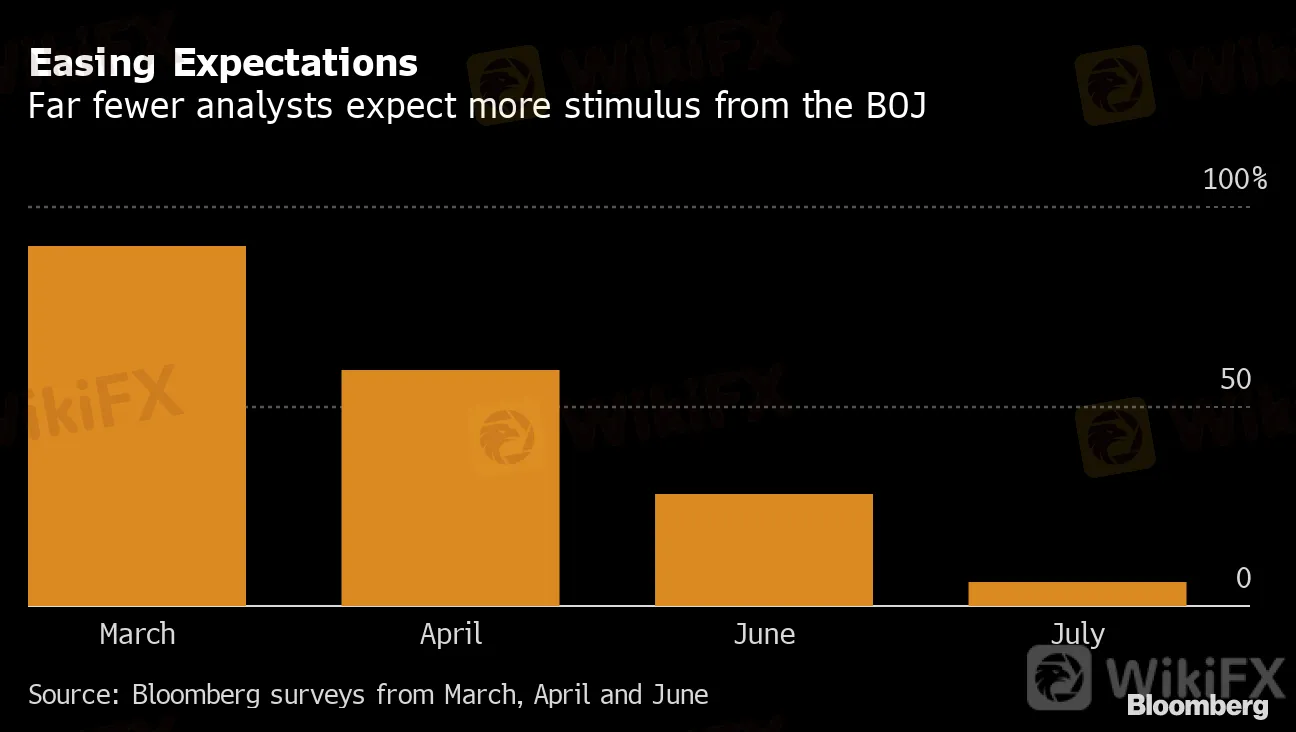简体中文
繁體中文
English
Pусский
日本語
ภาษาไทย
Tiếng Việt
Bahasa Indonesia
Español
हिन्दी
Filippiiniläinen
Français
Deutsch
Português
Türkçe
한국어
العربية
BOJ to Sit Tight While Assessing Virus Response: Decision Guide
Abstract:The Bank of Japan is expected to leave its main policy levers untouched Tuesday as it assesses a raft of measures already taken to support the pandemic-hit economy.
The Bank of Japan is expected to leave its main policy levers untouched Tuesday as it assesses a raft of measures already taken to support the pandemic-hit economy.
The BOJ is likely to leave interest rates and asset purchases unchanged at the end of its two-day meeting. Officials will consider the impact of measures taken so far to soften the virus blow and dont see a pressing need now for any further major moves, people familiar with the matter said.
Easing Expectations
Far fewer analysts expect more stimulus from the BOJ
Source: Bloomberg surveys from March, April and June

Many economists surveyed by Bloomberg expect the estimated size of a BOJ loan program linked to government lending to rise after Prime Minister Shinzo Abes administration announced an expansion of the lending measures last month.
Market fluctuations last week are far from the volatility observed in March and continued stability in the yen has given the BOJ breathing room to sit tight for the time being. The economy is also likely past its weakest point, following the lifting of Japans state of emergency in late May and the gradual easing of lockdowns in key export markets.
“No big move doesnt mean that the BOJ is free from any concerns,” said Tomo Kinoshita, global market strategist at Invesco Asset Management in Tokyo. “The BOJ will be checking what else needs to be done and communicating its willingness to do more.”
Since March, the bank has pledged unlimited purchases of government bonds, expanded its exchange-traded fund buying and launched loan programs as part of measures estimated to be worth about $700 billion.
The Federal Reserve last week painted a gloomy picture of the U.S. outlook and hinted that interest rates may effectively stay at zero through 2022. Governor Haruhiko Kuroda will probably sound a dovish tone at his post-decision press conference to avoid the possibility of the yen strengthening.
The BOJ policy statement is usually out in early afternoon with Kurodas press conference following at 3:30 p.m. in Tokyo.
What Bloombergs Economist Says
“A yen in a relatively comfortable range against the dollar also takes pressure off the BOJ to consider loosening policy. The yield differential with the U.S. is likely to limit any dollar weakness.”
Asia Economist Team
Click here to read more
What to look for
Economists will look to see if the BOJ changes the estimated size of its lending program and by how much. The BOJ initially estimated the programs size at about 30 trillion yen ($280 billion) as part of a 75 trillion yen package of virus-response financing measures.
Officials at the central bank wont characterize a higher figure for the lending program as an expansion of monetary easing as they never intended to put a cap on the size of the program, people familiar with the matter said.
After the Fed surprised investors last week by hinting it might keep rates near zero for years, Kuroda could make similar comments at the press briefing or in the BOJs forward guidance.
The BOJ will start to focus on whether companies are able to pay back loans and the effects on employment and Japan‘s lenders, with joint measures from the BOJ and the government to smooth business funding appearing to be working. Investors will be looking for any hints of the bank’s plans for addressing solvency issues.
Some traders want more clarity on the BOJs view on super-long bond yields, which touched the highest level in more than a year this month. BOJ watchers want to know if the board has shifted its focus to keeping yields low, from steepening the curve, before an increase in government bond issuances next month.
Policy Recap
The BOJ expects interest rates to remain at the current low level or even lower.
A rate of -0.1% on some reserves kept at the bank by financial institutions.
Yield target of about 0% for 10-year Japanese government bonds, with a trading range of about 0.2 percentage point on either side of the mark.
Will purchase Japanese government bonds as needed and without a limit, though the amount of purchases remains secondary to controlling interest rates.
A guideline to increase holdings of exchange-traded funds with an upper limit of 12 trillion yen a year. Actual purchases vary from month to month, depending on market conditions.
Active buying of corporate bonds and commercial paper with an expanded upper limit on holdings totaling 20 trillion yen.
Disclaimer:
The views in this article only represent the author's personal views, and do not constitute investment advice on this platform. This platform does not guarantee the accuracy, completeness and timeliness of the information in the article, and will not be liable for any loss caused by the use of or reliance on the information in the article.
WikiFX Broker
Latest News
Revolut X Expands Crypto Exchange Across Europe, Targeting Pro Traders
Broker Review: Is Exnova Legit?
Capital.com Shifts to Regional Leadership as CEO Kypros Zoumidou Steps Down
Crypto Scammer Pleads Guilty in $73 Million “Pig Butchering” Fraud
CWG Markets Got FSCA, South Africa Authorisation
Amazon launches Temu and Shein rival with \crazy low\ prices
CySEC Warns Against Unauthorized Investment Firms in Cyprus
Why Even the Highly Educated Fall Victim to Investment Scams?
Warning Against Globalmarketsbull & Cryptclubmarket
FBI Raids Polymarket CEO’s Home Amid 2024 Election Bet Probe
Currency Calculator


